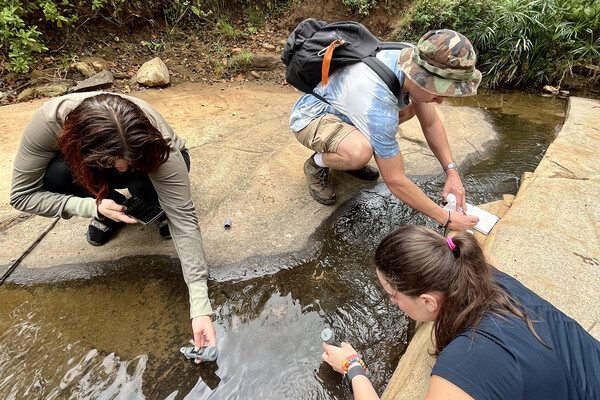
Griffin Pitt, right, works with two other student researchers to test the conductivity, total dissolved solids, salinity, and temperature of water below a sand dam in Kenya.
(Image: Courtesy of Griffin Pitt)

Upon infection or immunization, all jawed vertebrate species generate proteins called antibodies that bind and neutralize pathogens. Strong and long-lasting antibody responses in warm-blooded species such as mammals are produced in secondary lymphoid microstructures (SLMs) among which germinal centers (GCs) are the centerpiece. Despite the apparent absence of GCs or similar SLMs in cold-blooded vertebrates (e.g., fish), these species can mount significant antibody responses that can persist for several months. Thus, for decades, the outstanding question has remained as to how and where antibody responses are generated in species that lack GCs or analogous SLM structures.
A new study featured on the cover of the journal Science Immunology reconsiders the understanding of immune responses in cold-blooded species. Investigators at the University of Pennsylvania’s School of Veterinary Medicine (Penn Vet) have discovered, contrary to earlier belief, that induction of antibody responses in bony fish occurs in primordially organized SLMs that play roles similar to those of GCs from warm-blooded animals.
More specifically, the study identifies the formation in the spleen of large aggregates of highly proliferating B cells (the cells producing antibodies) and T cells (the cells helping B cells to produce antibodies) upon infection or immunization of fish. The newly induced B and T cell zones are formed nearby melanomacrophage centers (MMCs), which are tissue areas containing groups of dark-colored melanomacrophages where antigen is retained upon infection. These newly discovered MMC-associated lymphoid aggregates (M-LAs), contain numerous antigen-specific B cells, thus highlighting their key role in the immune response. Moreover, similar to what ensues in GCs, B cell clonal expansion and somatic hypermutation processes occur within M-LAs.
“Our findings challenge the former dogma that fish do not contain specific lymphoid microenvironments where immune responses are generated while revealing a previously unknown type of SLM in jawed vertebrates,” says J. Oriol Sunyer, corresponding author of the study, and professor of immunology at Penn Vet. “This discovery has far-reaching implications for our understanding of the immune system’s evolution and its potential applications in various fields, from fish vaccinology to human medicine.”
This story is by Martin. J. Hackett. Read more at Penn Vet News.
From Penn Vet

Griffin Pitt, right, works with two other student researchers to test the conductivity, total dissolved solids, salinity, and temperature of water below a sand dam in Kenya.
(Image: Courtesy of Griffin Pitt)

Image: Andriy Onufriyenko via Getty Images

nocred

Provost John L. Jackson Jr.
nocred